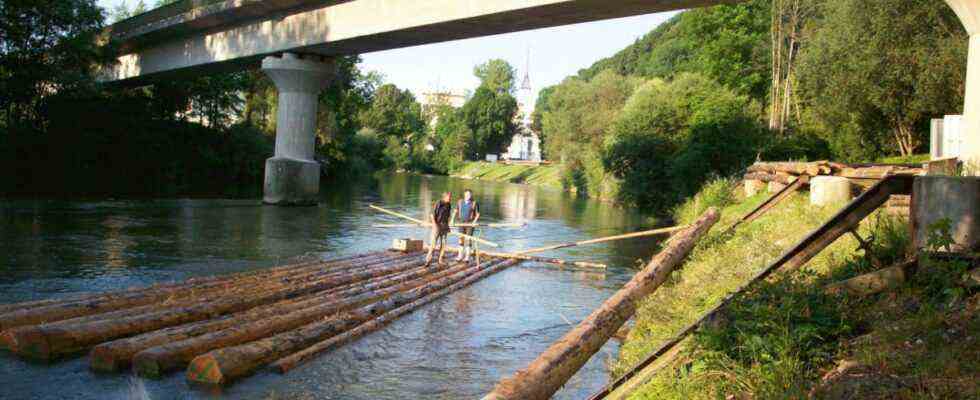The Isar raftsmen can still be seen today – on passenger trips or, as here, building rafts on the Loisach-Ländein Weidach.
(Photo: Monika Heidl-Seitner)
Munich likes to adorn itself with superlatives. The most beautiful beer gardens, the most successful football club, the oldest adult education center. Only one top position seems to have been forgotten: 150 years ago and for quite a while after that, Munich was Europe’s largest inland port. A kind of Duisburg-Ruhrort, except that ships were not the dominant means of transport, but rafts. In the record year of 1864, 11 145 of these tree barges reached the city, loaded with every conceivable goods. Beer and cheese, grindstones and sheep’s wool, chalk and balls of loden. But above all wood, a lot of wood, used, among other things, for the construction of the Frauenkirche.
At the transshipment points, the Untere Lände, the Oberen Lände and, from 1899 on, also at the central area in Thalkirchen, there was a hustle and bustle that one cannot imagine turbulent enough. The splendor of the traditional handicraft, its paramount importance for the development of the city only faded with the advent of the railroad and trucks. All that remains are the passenger raft trips between Wolfratshausen and Thalkirchen, a lively pleasure. Due to Corona, however, there has been a compulsory break since 2020. It is not clear when a “cast off” will be heard again on the banks of the river.
Helga Lauterbach has made it her business to remember the “rulers of the waterways”, the raftsmen on the Isar, Loisach and Danube. The Munich resident, who is anchored in Sendling, has been writing articles about rafting in all of its fascinating facets for 30 years. Now she has presented a comprehensive work on the subject of her life, partly based on older texts but expanded by many chapters: “Raft Masters and Rafters Customs”. A compendium of history and stories, illustrated with historical images, the like of which no other exhibition has shown in this abundance. The author, co-founder and board member of the Flößer-Kulturverein München-Thalkirchen, speaks of her “Flößerweg” in the foreword. This leads to a documentation that is reminiscent of higher water levels.
Proud guild and once economically important: the Isar raftsmen.
(Photo: Archives Helga Lauterbach)
The proud guild of raftsmen, they have their own rites and laws. Trusting in their patron saint St. Nicholas and the bridge saint St. Nepomuk, strong guys have been steering their companions made of spruce trunks through rapids, past rocks and pillars for hundreds of years. But it has always been the case: keep your eyes open when choosing a career and especially when exercising your profession. Otherwise it might be like the raft master Josef Pichlmayr a long time ago. With 17 pilgrims on board, he rammed a dam. All passengers perished in the raging waters of the Isar. Pichlmayr was temporarily banned from working and was ordered to organize church trips at his own expense, including to Altötting. The man took the punishment as an incentive and later steered rafts with a sure hand as far as Vienna.
The raftsmen followed strict rules through their professional life. They should “abstain from cursing and blasphemy” and should not try to resolve “trade disputes” by “simply running away”. It can be strongly assumed that some bids in the usual guild drinking competitions in Munich inns were temporarily canceled. Many a muscular man from the Isarwinkel should therefore have only just escaped the loss of the “right to seduction”. That was not a license to show the bride, but the official transport authorization.
Anyone who walks in the area around the Thalkirchen campsite or in the allotment garden behind the Asamschlößl, on the Westermühlbach in front of the Sendlinger Tor or on the Steinsdorfstrasse would inevitably have got their feet wet at the end of the 19th century. Because that is where the harbor basins of the lands extended. They were a very lucrative source of income for the city. Municipal land master – Anton Konz was the name of the first – collected storage and storage fees, “land and hanging money”. By the way, they avidly made use of their “Bierzäpflersrechte”, a liquor license. They are said to have rarely lacked hard-drinking guests.
At the time of the First World War, when there was a noticeable shortage of men on Loisach and Isar due to military mobilization, Anna Taubenberger was one of the first raftsmen to take over the helm. Before that, the authorities had to dispel doubts about the “morality” of such operations with “women”. It was only with the introduction of women’s suffrage that such reservations fell silent. At that time there were still “wooden beggars” standing on the banks, impoverished people to whom generous raftsmen threw wooden sticks for heating.
The history of rafting is at the same time a history of pilgrimage, impressively symbolized by the church of St. Maria Thalkirchen. The church still houses valuable mementos of the proud handicraft, such as artfully decorated guild poles, a procession standard and the raftsman’s flag. At the junction of the raft canal in Hinterbrühl, the larger than life bronze raftsman figure by the sculptor Fritz Koelle has been greeting us since 1939. And in 2014 rafting was recognized by Unesco as an Intangible Cultural Heritage. More waves for a saga of superlatives is hardly possible. If you ignore it, you should sit in front of one of the 18-ton wooden colossi and go swimming on the 360-meter-long raft slide in Mühltal.
Helga Lauterbach: “Floßmeister und Flößerbräuche”, Verlag Schnell + Steiner, Regensburg, 192 pages

